A Novel Bi2MoO6/ZIF-8 Composite for Enhanced Visible Light Photocatalytic Activity
Abstract
:1. Introduction
2. Experimental Section
2.1. Preparation of Bi2MoO6
2.2. Preparation of Bi2MoO6/ZIF-8 Composites
2.3. Characterization
2.4. Evaluation of Photocatalytic Performance
3. Results and Discussion
3.1. XRD Analysis
3.2. Scanning Electron Microscopy (SEM) Analysis
3.3. X-ray Photoelectron Spectroscopy (XPS) Analysis
3.4. Photocatalytic Activities
4. Conclusions
Author Contributions
Funding
Acknowledgments
Conflicts of Interest
References
- Yue, D.T.; Qian, X.F.; Zhao, Y.X. Photocatalytic remediation of ionic pollutant. Sci. Bull. 2015, 60, 1791–1806. [Google Scholar] [CrossRef]
- Si, Y.H.; Xia, Y.; Shang, S.K.; Xiong, X.B.; Zeng, X.R.; Zhou, J.; Li, Y.Y. Enhanced visible light driven photocatalytic behavior of BiFeO3/ Reduced Graphene Oxide composites. Nanomaterials 2018, 8, 526. [Google Scholar] [CrossRef] [PubMed]
- Shang, L.; Tong, B.; Yu, H. CdS Nanoparticle-decorated Cd nanosheets for efficient visible light-driven photocatalytic hydrogen evolution. Adv. Energy Mater. 2016, 6, 1501241–1501247. [Google Scholar] [CrossRef]
- Devi, L.G.; Kavitha, R. A review on nonmetal ion doped titania for the photocatalytic degradation of organic pollutants under UV/solar light: Role of photogenerated charge carrier dynamics in enhancing the activity. Appl. Catal. B Environ. 2013, 140, 559–587. [Google Scholar] [CrossRef]
- Shimodaira, Y.; Kato, H.; Kobayashi, H.; Kudo, A. Photophysical properties and photocatalytic activities of bismuth molybdates under visible light irradiation. J. Phys. Chem. B 2006, 110, 17790–17797. [Google Scholar] [CrossRef] [PubMed]
- Tian, G.H.; Chen, Y.J.; Zhou, W.; Pan, K.; Dong, Y.Z. Facile solvothermal synthesis of hierarchical flower-like Bi2MoO6 hollow spheres as high performance visible-light driven photocatalysts. J. Mater. Chem. 2011, 21, 887–892. [Google Scholar] [CrossRef]
- Li, S.J.; Shen, X.F.; Liu, J.S.; Zhang, L.S. Synthesis of Ta3N5/Bi2MoO6 core-shell fiber shaped heterojunctions as efficient and easily recyclable photocatalysts. Environ. Sci. Nano 2017, 4, 1155–1167. [Google Scholar] [CrossRef]
- Li, X.X.; Fang, S.M.; Ge, L.; Han, C.C.; Qiu, P.; Liu, W.L. Synthesis of flower-like Ag/AgCl-Bi2MoO6 plasmonic photocatalysts with enhanced visible-light photocatalytic performance. Appl. Catal. B Environ. 2015, 176, 62–69. [Google Scholar] [CrossRef]
- Wang, M.; Han, J.; Guo, P.Y.; Sun, M.Z.; Zhang, Y.; Tong, Z.; You, M.Y.; Lv, C.M. Hydrothermal synthesis of B-doped Bi2MoO6 and its high photocatalytic performance for the degradation of Rhodamine B. J. Phys. Chem. Solids 2018, 113, 86–93. [Google Scholar] [CrossRef]
- Wang, D.J.; Shen, H.D.; Guo, L.; Wang, C.; Fu, F.; Liang, Y.C. Ag/Bi2MoO6-x with enhanced visible-light-responsive photocatalytic activities via the synergistic effect of surface oxygen vacancies and surface plasmon. Appl. Surf. Sci. 2018, 436, 536–547. [Google Scholar] [CrossRef]
- Liu, D.; Wang, J.; Wang, Y.G.; Zhu, Y.F. An anion exchange strategy for construction of a novel Bi2SiO5/Bi2MoO6 heterostructure with enhanced photocatalytic performance. Catal. Sci. Technol. 2018, 8, 3278. [Google Scholar] [CrossRef]
- Jiang, H.L.; Makal, T.A.; Zhou, H.C. Interpenetration control in metal-organic frameworks for functional applications. Chem. Rev. 2013, 257, 2232–2249. [Google Scholar] [CrossRef]
- Farha, O.K.; Hupp, J.T. Rational design, synthesis, purification, and activation of metal-organic framework materials. Acc. Chem. Res. 2010, 43, 1166–1175. [Google Scholar] [CrossRef] [PubMed]
- Li, J.R.; Kuppler, R.J.; Zhou, H.C. Selective gas adsorption and separation in metal-organic frameworks. Chem. Soc. Rev. 2009, 38, 1477–1504. [Google Scholar] [CrossRef] [PubMed]
- Ke, F.; Wang, L.; Zhu, J. Facile fabrication of CdS-metal-organic framework nanocomposites with enhanced visible-light photocatalytic activity for organic transformation. Nano Res. 2015, 8, 1834–1846. [Google Scholar] [CrossRef]
- Lu, Z.Z.; Zhang, R.; Li, Y.Z. Solvatochromic behavior of a nanotubular metal-organic framework for sensing small molecules. J. Am. Chem. Soc. 2011, 133, 4172–4174. [Google Scholar] [CrossRef]
- An, J.Y.; Gei, S.J.; Rosi, N.L. Cation-Triggered Drug Release from a Porous Zinc-Adeninate Metal-Organic Framework. J. Am. Chem. Soc. 2009, 131, 8376–8377. [Google Scholar] [CrossRef]
- Zeng, X.; Huang, L.Q.; Wang, C.N.; Wang, J.S.; Li, J.T.; Luo, X.T. Sonocrystallization of ZIF-8 on electrostatic spinning TiO2 nanofibers surface with enhanced photocatalysis property through synergistic effect. ACS Appl. Mater. Interfaces 2016, 8, 20274–20282. [Google Scholar] [CrossRef] [PubMed]
- Ding, Y.H.; Zhang, X.L.; Zhang, N.; Zhang, J.Y.; Zhang, R.; Liu, Y.F.; Fang, Y.Z. A visible-light driven Bi2S3@ZIF-8 core-shell heterostructure and synergistic photocatalysis mechanism. Dalton Trans. 2018, 47, 684–692. [Google Scholar] [CrossRef]
- Zhang, J.L.; Liu, H.; Ma, Z. Flower-like Ag2O/Bi2MoO6 p-n heterojunction with enhanced photocatalytic activity under visible light irradiation. J. Mol. Cata. A Chem. 2016, 424, 37–44. [Google Scholar] [CrossRef]
- Venna, S.R.; Jasinski, J.B.; Carreon, M.A. Structural evolution of zeolitic imidazolate framework-8. J. Am. Chem. Soc. 2010, 132, 18030–18033. [Google Scholar] [CrossRef] [PubMed]
- Liu, Y.; Yang, Z.H.; Song, P.P.; Xu, R.; Wang, H. Facile synthesis of Bi2MoO6/ZnSnO3 heterojunction with enhanced visible light photocatalytic degradation of methylene blue. Appl. Surf. Sci. 2018, 430, 561–570. [Google Scholar] [CrossRef]
- Xia, K.X.; Chen, H.X.; Mao, M.; Chen, Z.G.; Xu, F.; Yi, J.J.; Yu, Y.H.; She, X.J. Designing visible-light-driven z-Scheme catalyst 2D g-C3N4/Bi2MoO6: Enhanced photodegradation activity of organic pollutants. Phys. Status Solidi A 2018, 215, 1800520. [Google Scholar] [CrossRef]
- Liu, X.; Zhang, J.; Dong, Y.M.; Li, H.X.; Xia, Y.M.; Wang, H.J. A facile approach for the synthesis of Z-scheme photocatalyst ZIF-8/g-C3N4 with highly enhanced photocatalytic activity under simulated sunlight. New J. Chem. 2018, 42, 12180–12187. [Google Scholar] [CrossRef]
- Zhang, M.Y.; Shao, C.L.; Mu, J.B.; Zhang, Z.Y.; Guo, Z.C.; Zhang, P.; Liu, Y.C. One-dimensional Bi2MoO6/TiO2 hierarchical heterostructures with enhanced photocatalytic activity. CrystEngComm 2012, 14, 605–612. [Google Scholar] [CrossRef]
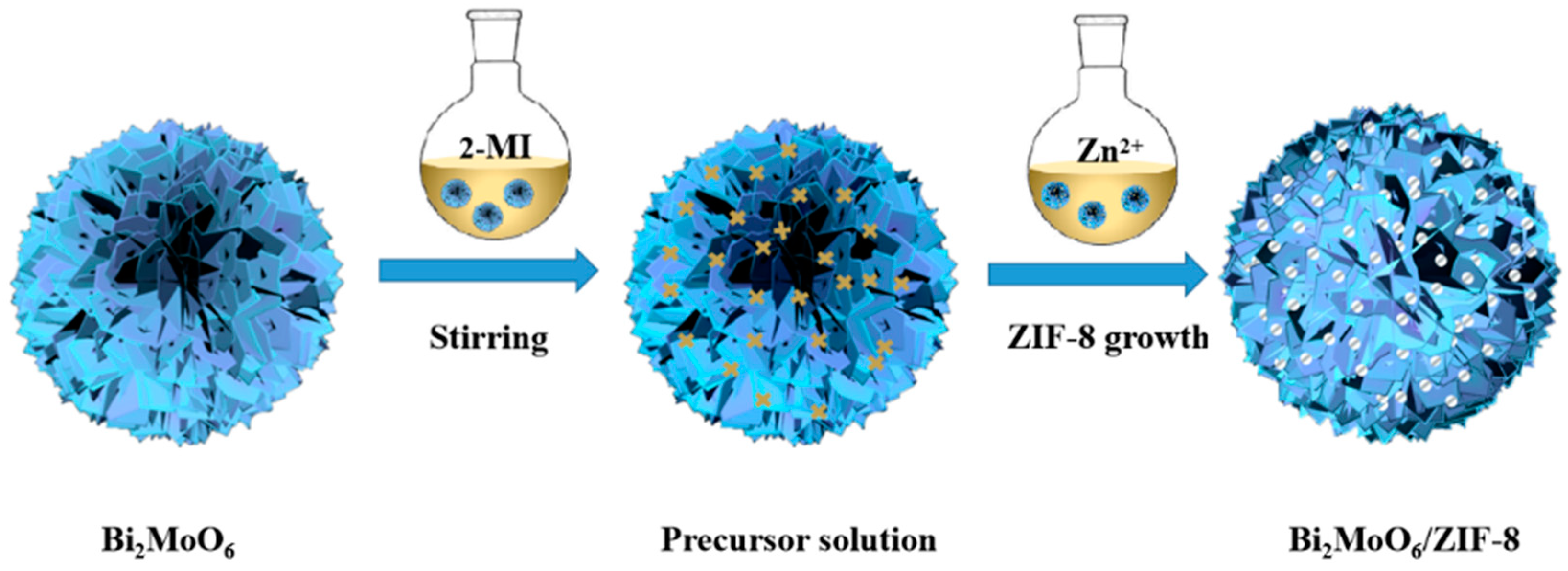
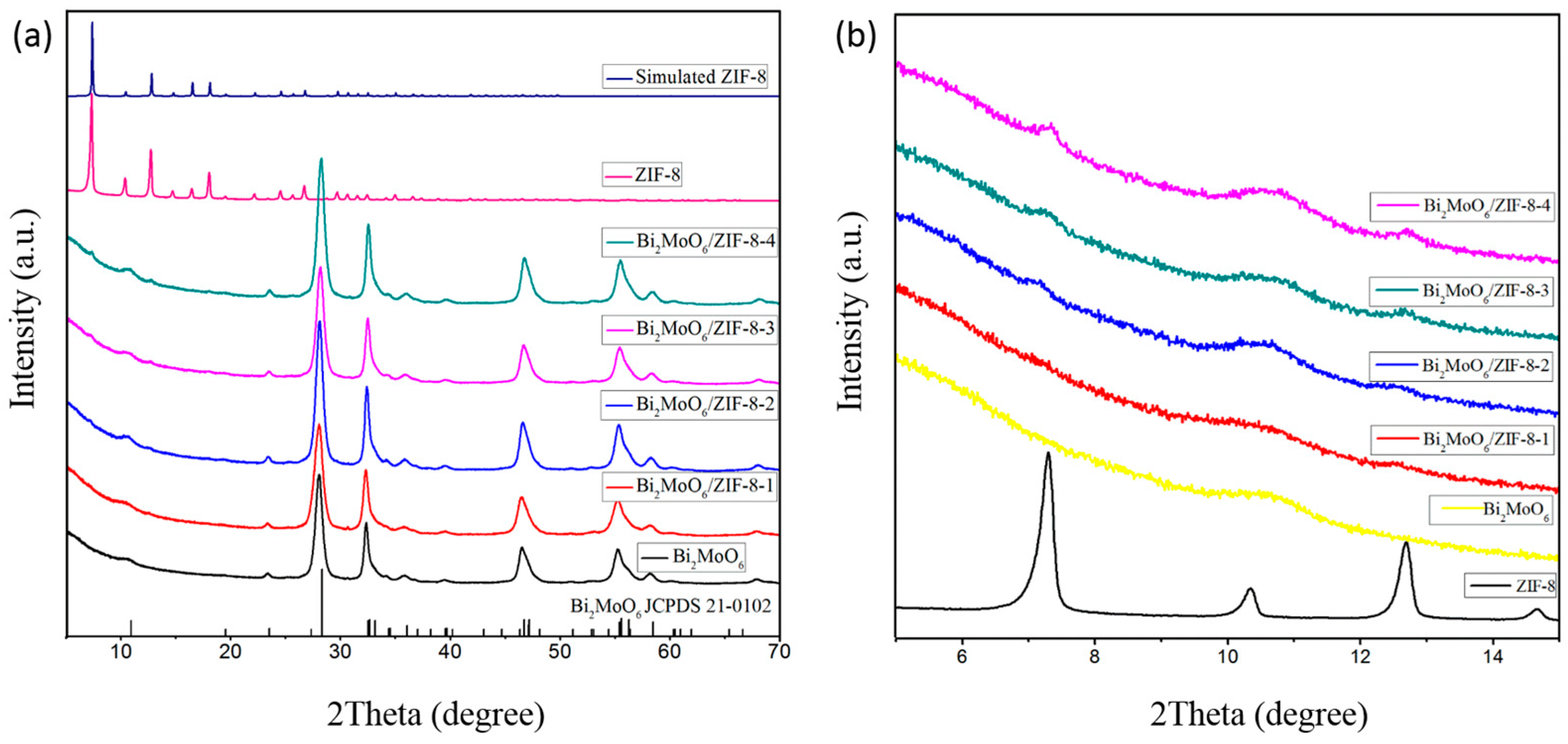
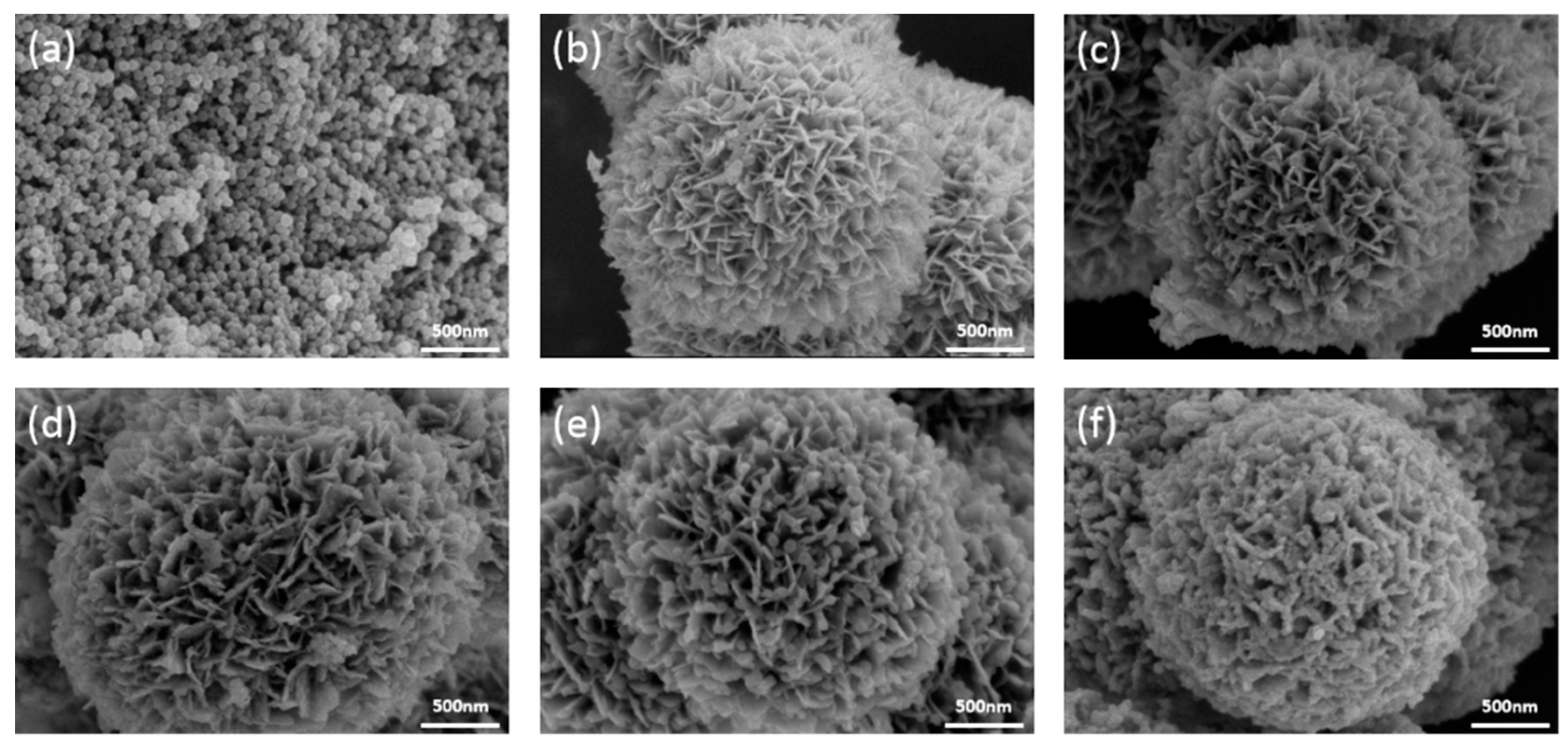
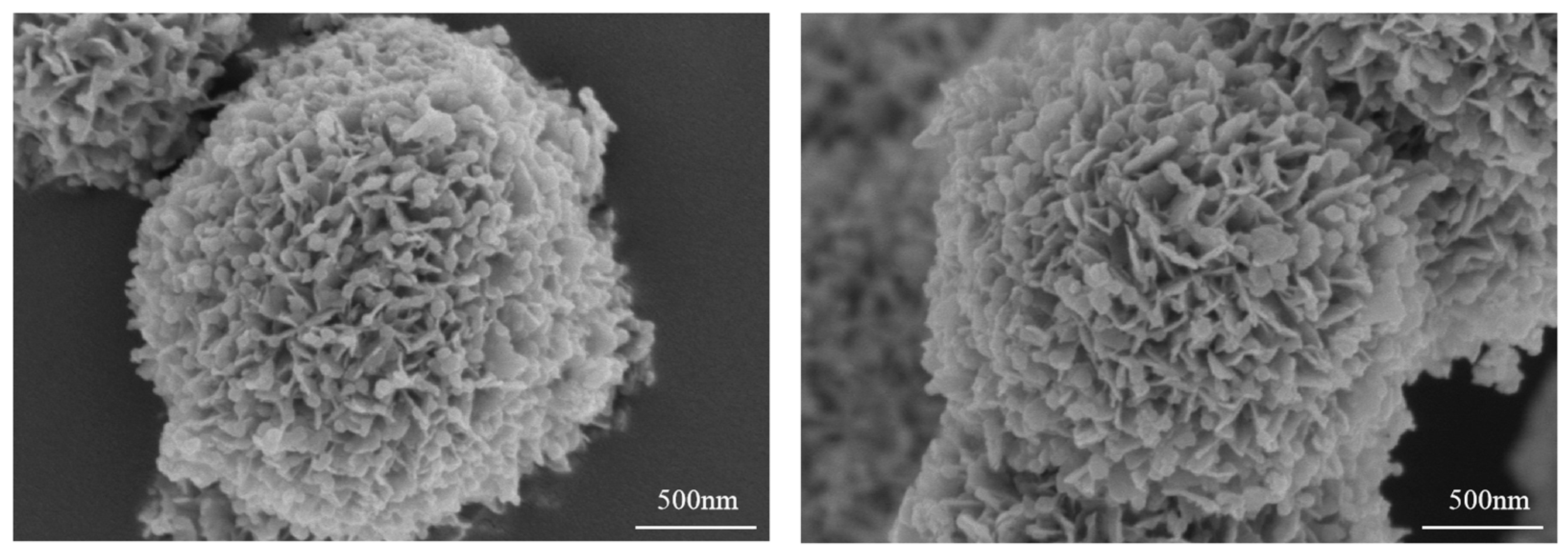
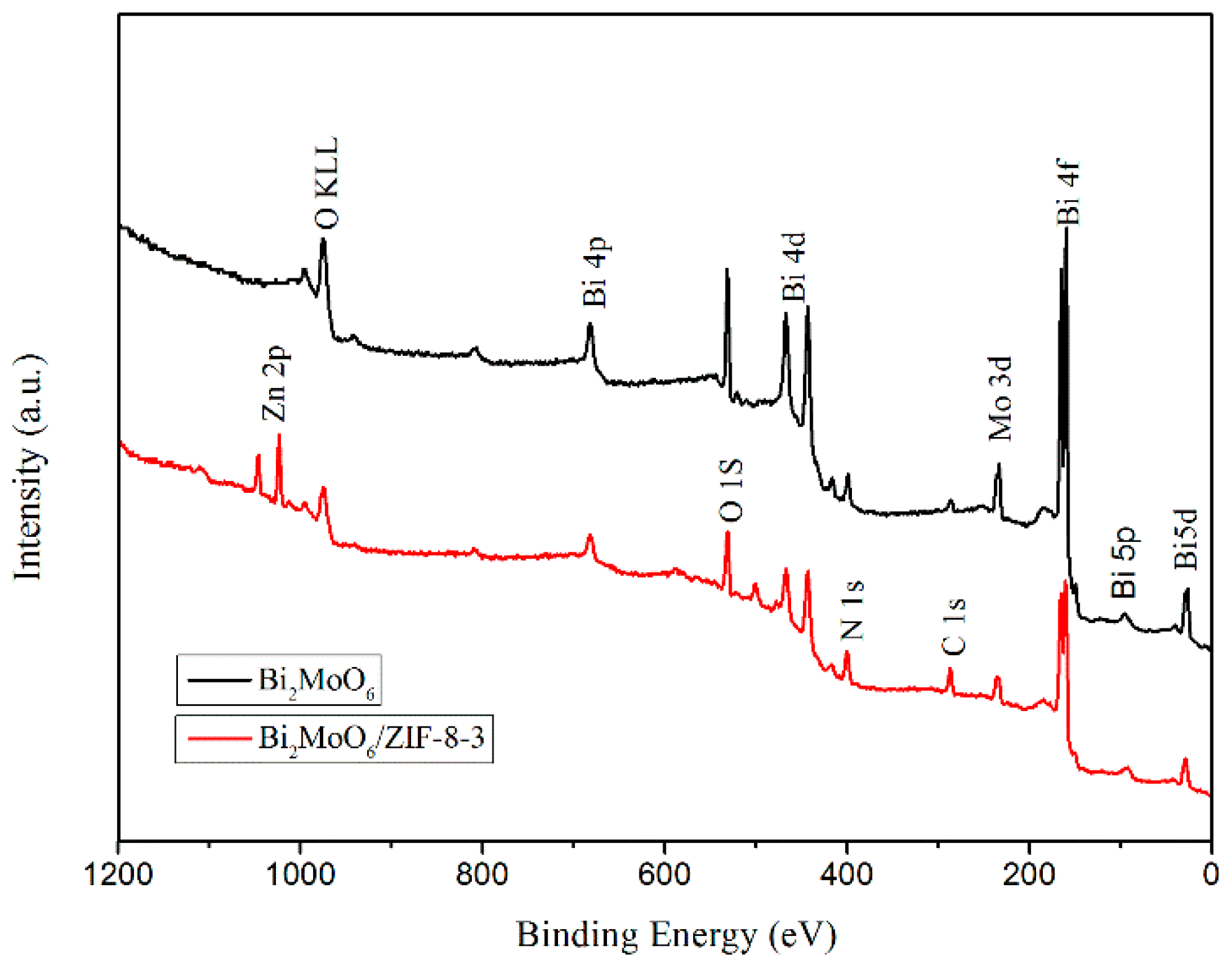
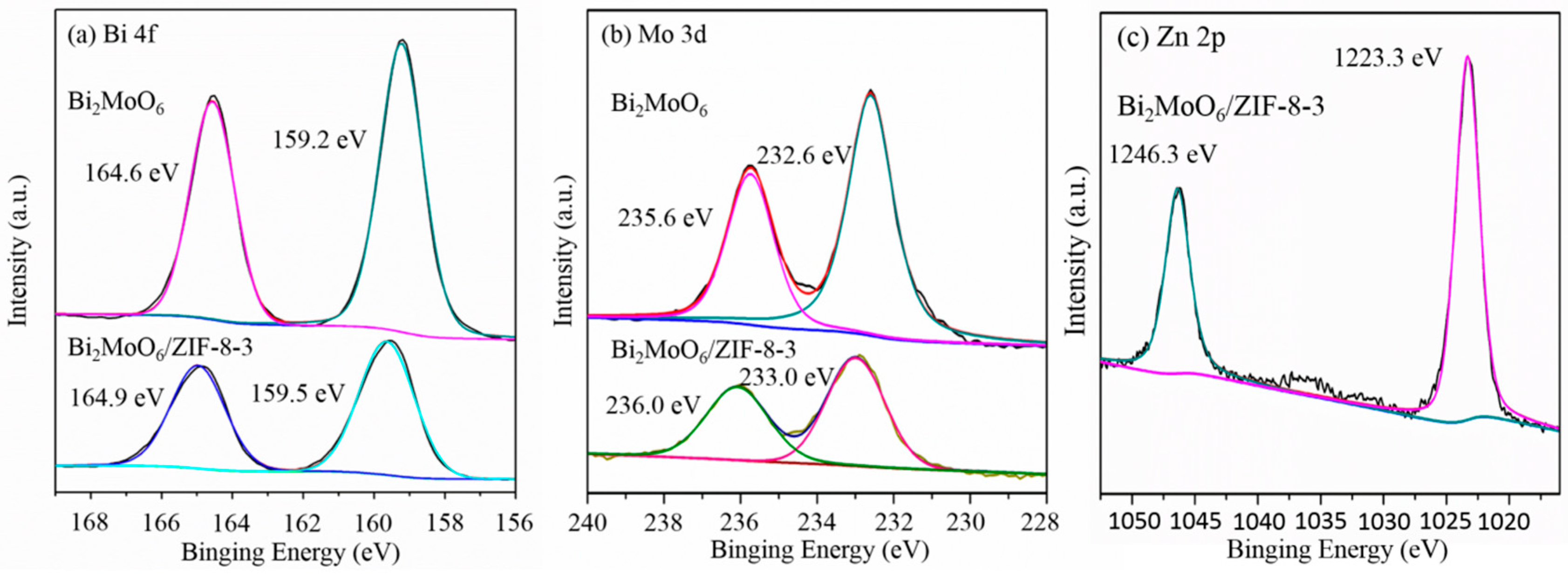
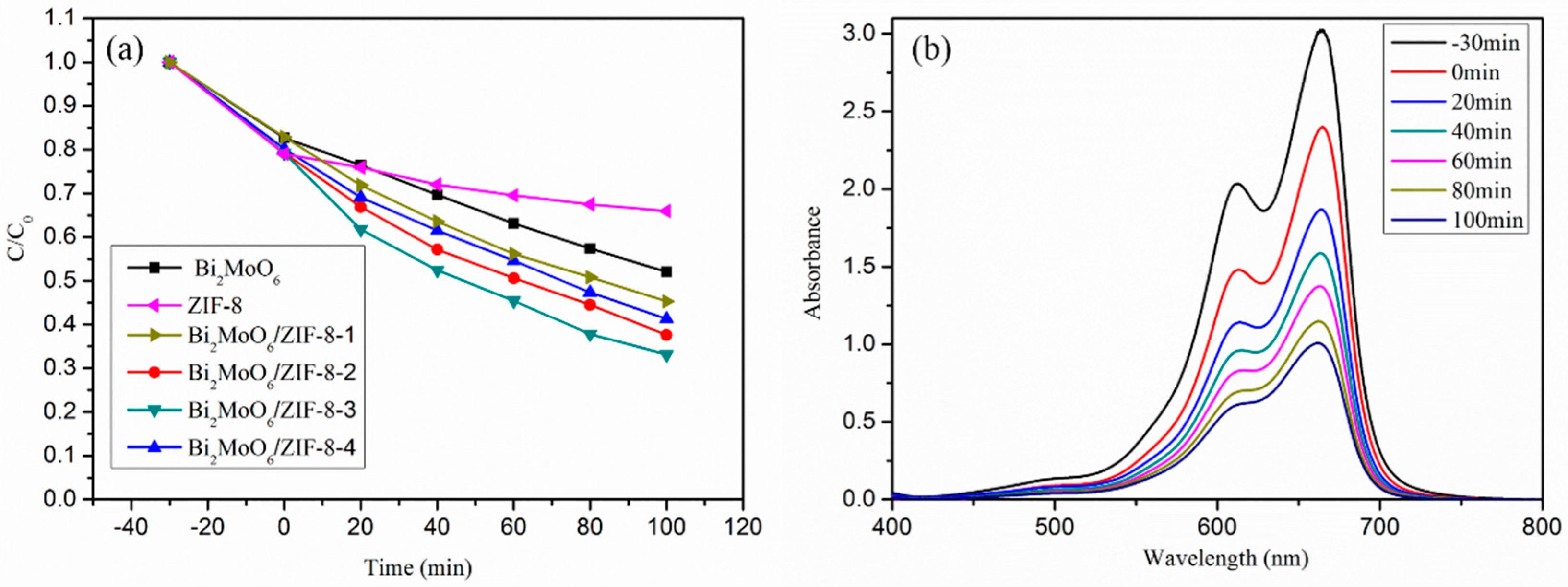
© 2019 by the authors. Licensee MDPI, Basel, Switzerland. This article is an open access article distributed under the terms and conditions of the Creative Commons Attribution (CC BY) license (http://creativecommons.org/licenses/by/4.0/).
Share and Cite
Xia, Y.; Shang, S.-k.; Zeng, X.-r.; Zhou, J.; Li, Y.-y. A Novel Bi2MoO6/ZIF-8 Composite for Enhanced Visible Light Photocatalytic Activity. Nanomaterials 2019, 9, 545. https://doi.org/10.3390/nano9040545
Xia Y, Shang S-k, Zeng X-r, Zhou J, Li Y-y. A Novel Bi2MoO6/ZIF-8 Composite for Enhanced Visible Light Photocatalytic Activity. Nanomaterials. 2019; 9(4):545. https://doi.org/10.3390/nano9040545
Chicago/Turabian StyleXia, Yu, Shao-ke Shang, Xie-rong Zeng, Ji Zhou, and Ya-yun Li. 2019. "A Novel Bi2MoO6/ZIF-8 Composite for Enhanced Visible Light Photocatalytic Activity" Nanomaterials 9, no. 4: 545. https://doi.org/10.3390/nano9040545
APA StyleXia, Y., Shang, S.-k., Zeng, X.-r., Zhou, J., & Li, Y.-y. (2019). A Novel Bi2MoO6/ZIF-8 Composite for Enhanced Visible Light Photocatalytic Activity. Nanomaterials, 9(4), 545. https://doi.org/10.3390/nano9040545




